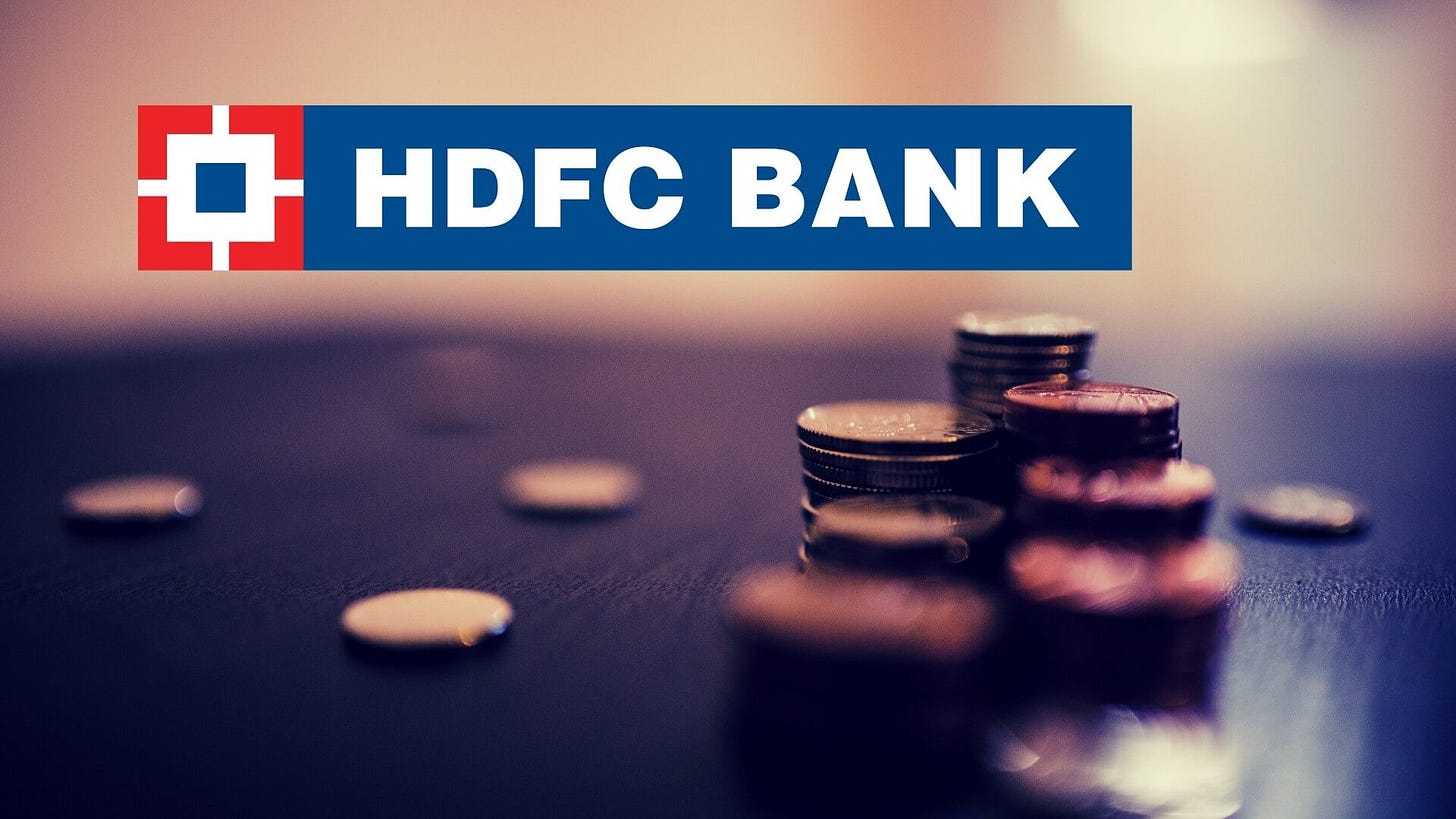HDFC Bank Q4 FY25 Preview: Modest Profit Rise, Steady Margins, Improving Asset Quality
Day 58 of tracking the Indian banking sector
As India’s largest private sector lender, HDFC Bank, prepares to reveal its Q4 FY25 earnings, analysts and investors alike are keenly observing the numbers. Brokerages project a cautious yet positive performance, characterized by a modest profit rise, stable margins, and a marked improvement in asset quality.
This article talks about the key financial metrics, offering detailed explanations of the figures, their implications, and what they signal for the bank’s future, all grounded in the latest broker estimates and provisional data.
A Snapshot
HDFC Bank is expected to post a profit after tax (PAT) increase of 2.5–7% year-on-year (YoY), reaching between ₹16,918 crore and ₹17,650 crore for the quarter ending March 2025.
This growth is fueled by a 5.5–9% YoY rise in net interest income (NII), forecasted at ₹30,669 crore to ₹31,640 crore.
Meanwhile, pre-provision operating profit (PPOP) is pegged at ₹25,671 crore, reflecting a 12% YoY decline but a 3% quarter-on-quarter (QoQ) gain.
The bank’s net interest margins (NIM) are holding steady near 3.5%, supported by a favorable lending-deposit dynamic.
On the balance sheet, loan growth is moderating at 5.4% YoY to ₹26.43 trillion, while deposits surge by an impressive 14.1% YoY to ₹27.15 trillion.
A standout feature is the 78% YoY drop in provisions to ₹2,962 crore, underscoring improved asset quality and a solid earnings foundation.
Key Metrics in Focus
In Q4 FY25, HDFC Bank is expected to report a net interest income (NII) of ₹31,248 crore, marking a 7% increase from the same quarter last year when it stood at ₹29,077 crore.
This growth is driven by a favorable lending-deposit dynamic, with deposits surging by 14.1% YoY to ₹27.15 trillion, while loans grow more modestly at 5.4% YoY to ₹26.43 trillion.
The bank’s net interest margin (NIM) is projected to remain stable at around 3.40–3.50%, indicating effective management of funding costs despite competitive pressures.
On the profitability front, profit after tax (PAT) is forecasted to rise by 2.5–7% YoY to between ₹16,918 crore and ₹17,650 crore, supported by a significant 78% drop in provisions to ₹2,962 crore, a sharp decline from ₹13,512 crore in Q4 FY24. This reduction in provisions showcases improved asset quality and fewer bad loans.
However, pre-provision operating profit (PPOP) is expected to decline by 12% YoY to ₹25,671 crore, though it shows a 3% increase from the previous quarter, reflecting operational effectiveness amid weaker treasury and fee income.
Profitability Analysis
The anticipated PAT of ₹17,095 crore (central estimate) reflects a balanced performance. Brokerage Motilal Oswal predicts a conservative ₹17,030 crore (3.2% YoY growth), while IIFL projects a higher ₹17,600 crore (7% YoY), highlighting optimism around lower provisions and steady margins.
The modest YoY growth is tempered by one-off expenses and seasonal provisions, but the sequential 2% QoQ rise from ₹16,736 crore in Q3 FY25 signals underlying stability.
This profit rise is largely driven by the significant reduction in provisions, which frees up capital and allows more earnings to flow to the bottom line.
The 78% YoY decline in provisions to ₹2,962 crore reflects fewer bad loans and a proactive approach to risk management, positioning the bank well for future growth .
Net Interest Income & Margins
NII, the core of banking profitability, measures the difference between income from loans and the cost of deposits. For Q4 FY25, it’s projected to grow by 7% YoY to ₹31,248 crore, up from ₹29,077 crore in Q4 FY24.
Broker estimates vary slightly, with a range of ₹30,669 crore to ₹31,640 crore, reflecting healthy lending income growth despite cautious credit expansion .
The NIM remains resilient at 3.40–3.50%, a slight improvement from Q3 FY25’s 3.37% but flat compared to Q4 FY24’s 3.53%.
Loan & Deposit Growth
Gross advances grew by a modest 5.4% YoY to ₹26.43 trillion, a slowdown from previous quarters.
In contrast, total deposits soared by 14.1% YoY to ₹27.15 trillion, driven by strong retail and institutional inflows. Breaking it down:
CASA (Current and Savings Account) deposits rose to ₹9.45 lakh crore, up 3.9% YoY and 8.2% QoQ, reinforcing a low-cost funding base.
Time deposits climbed 20.3% YoY to ₹17.70 lakh crore, reflecting savers’ preference for higher-yield options.
This deposit-loan mismatch strengthens liquidity, positioning HDFC Bank to fund future growth without straining margins.
Asset Quality & Provisions
HDFC Bank’s asset quality continues to shine:
The gross NPA ratio holds steady at 1.4%, with slippages in retail and SME loans well-contained.
The net NPA ratio improves to 0.4% from 0.5%.
The 78% YoY reduction in provisions to ₹2,962 crore, down from ₹13,512 crore in Q4 FY24, frees up capital and signals confidence in loan recovery.
This drop in credit costs creates a buffer against potential economic shocks, making HDFC Bank a standout in the sector.
Outlook & Key Takeaways: What Lies Ahead
Balanced Growth: With PAT growth capped at 7% YoY, stable NIMs, and improving asset quality, HDFC Bank exemplifies cautious optimism in a challenging credit environment.
Liquidity Strength: A 14.1% YoY deposit surge and high CASA base ensure cost-efficient funding for future lending.
Earnings Drivers: Margin expansion, fee income growth, and declining credit costs could unlock further upside.
Industry Benchmark: As India’s top private lender, HDFC Bank’s performance will shape expectations for the banking sector’s Q4 FY25 earnings season.
Follow me in my journey of documenting the Indian banking sector . Feel free like, share, and restack!
Don’t forget to check out The Valuation School Weekly and thank you for inspiring me Parth Verma.




